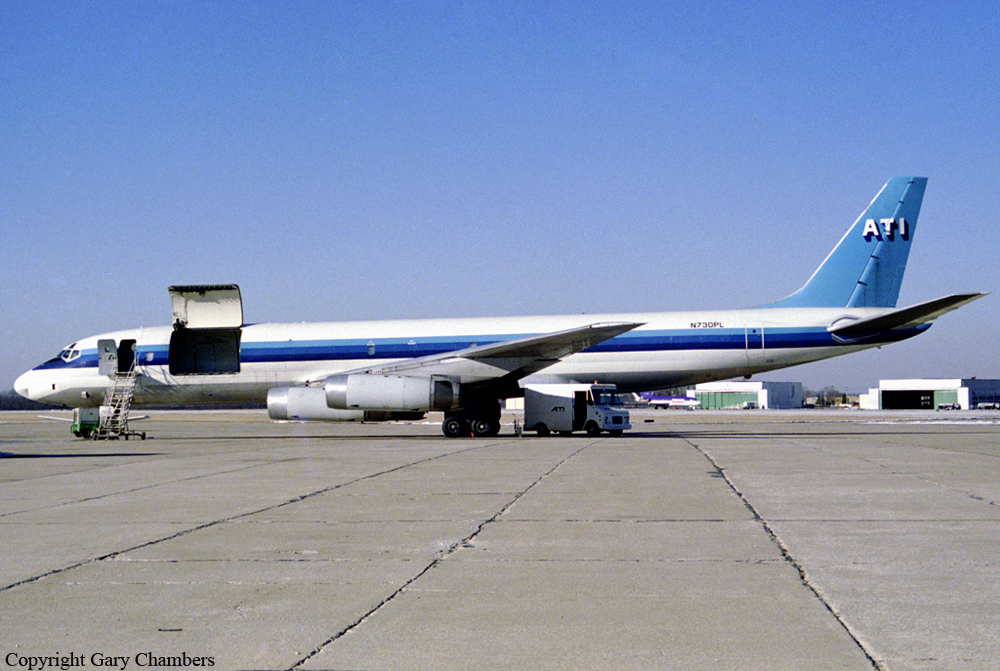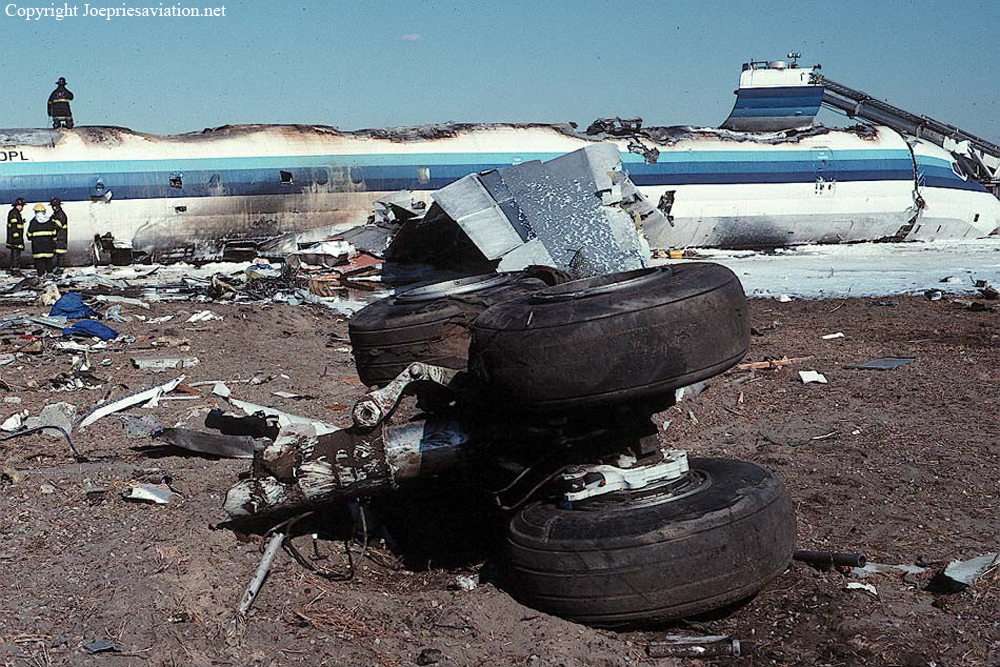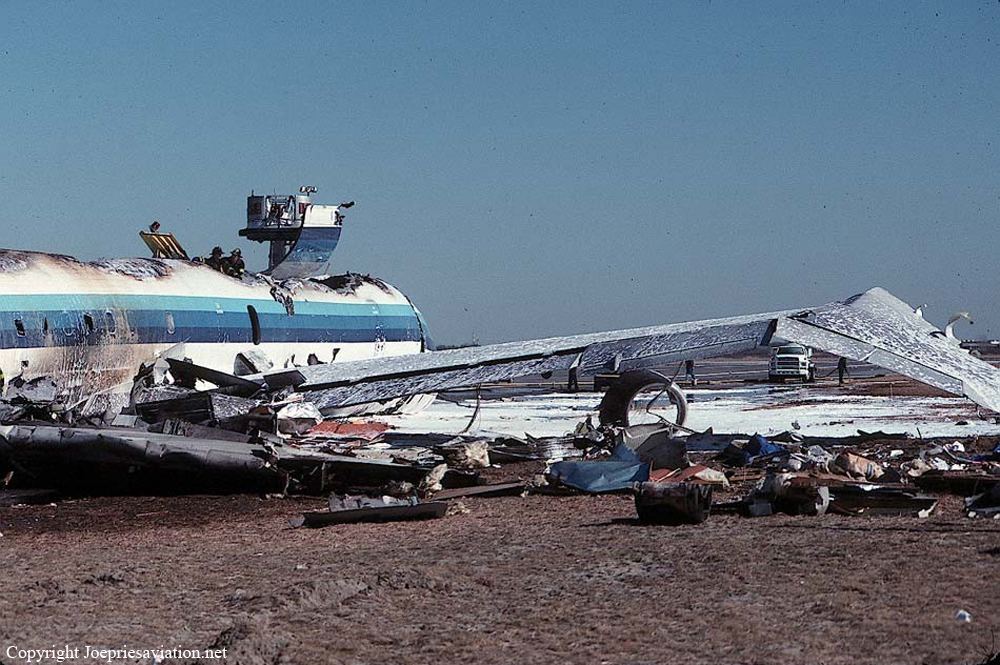Country
Crash of a Douglas DC-8-54F in Guatemala City: 6 killed
Date & Time:
Apr 28, 1995 at 1135 LT
Registration:
N43UA
Survivors:
Yes
Schedule:
Miami – Guatemala City – Lima
MSN:
45677
YOM:
1964
Flight number:
OX705
Crew on board:
3
Crew fatalities:
Pax on board:
0
Pax fatalities:
Other fatalities:
Total fatalities:
6
Circumstances:
The aircraft departed Miami-Intl Airport on a cargo flight to Lima with an intermediate stop in Guatemala City, carrying three crew members and various goods on behalf of Lineas Aéreas Mayas. After touchdown on runway 19 at Guatemala City-La Aurora Airport, spoilers were deployed as well as reverse thrust on engine n°2 and 3. On a wet runway surface, the aircraft was unable to stop within the remaining distance, overran, went through a fence and down an embankment before crashing onto several houses. All three crew members were injured as well as seven people on the ground. Six other people on the ground were killed.
Probable cause:
Wrong approach configuration on part of the crew who landed at an excessive speed of 135 knots in marginal weather conditions. The following contributing factors were reported:
- The runway surface was wet,
- The braking action was poor,
- The crew failed to take corrective actions in time,
- Possible aquaplaning,
- The crew failed to use all available brake systems.
- The runway surface was wet,
- The braking action was poor,
- The crew failed to take corrective actions in time,
- Possible aquaplaning,
- The crew failed to use all available brake systems.

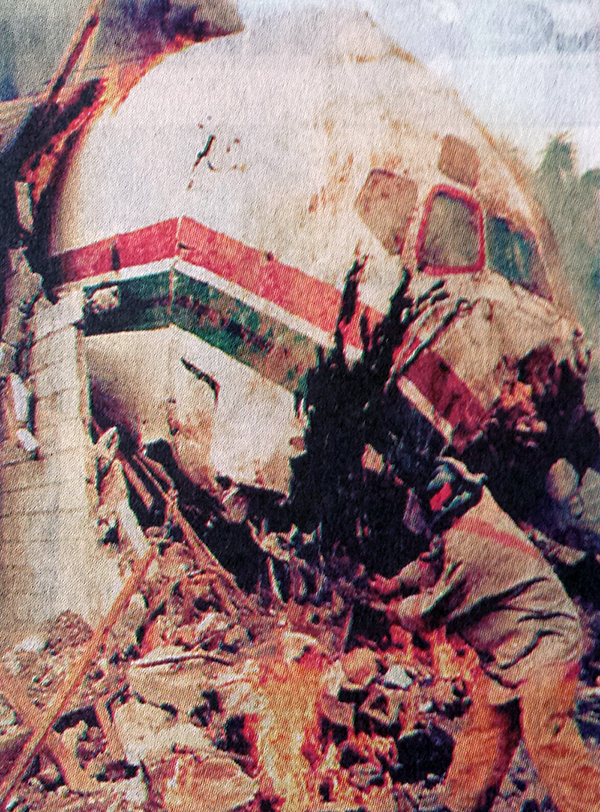
Crash of a Douglas DC-8-63CF in Kansas City: 3 killed
Date & Time:
Feb 16, 1995 at 2027 LT
Registration:
N782AL
Survivors:
No
Schedule:
Kansas City - Westover
MSN:
45929
YOM:
1968
Crew on board:
3
Crew fatalities:
Pax on board:
0
Pax fatalities:
Other fatalities:
Total fatalities:
3
Captain / Total hours on type:
4483.00
Copilot / Total hours on type:
218
Aircraft flight hours:
77096
Aircraft flight cycles:
22404
Circumstances:
The airplane crashed immediately after liftoff during a three-engine takeoff. Flightcrew had shortened rest break; rest periods not required for ferry flights. Flight crew fatigue from lack of rest, sleep, and disruption of circadian rhythms. Flightcrew did not have adequate, realistic training in three-engine takeoff techniques or procedures. Flight crew did not adequately understand three-engine takeoff procedures, including significance of vmcg. Flight engineer improperly determined vmcg speed, resulting in value 9 knots too low. During first takeoff attempt, captain applied power to asymmetrical engine too soon, was unable to maintain directional control, and rejected the takeoff. Captain agreed to modify procedure by allowing flight engineer to advance throttle, a deviation of prescribed procedure. FAA oversight of operator was inadequate because the poi and geographic inspectors were unable to effectively monitor domestic crew training and international operations. Existing far part 121 flight time limits & rest requirements that pertained to the flights that the flightcrew flew prior to the ferry flights did not apply to the ferry flights flown under far part 91. Current one-engine inoperative takeoff procedures do not provide adequate rudder availability for correcting directional deviations during the takeoff roll compatible with the achievement of maximum asymmetric thrust at an appropriate speed greater than ground minimum control speed. All three crew members were killed.
Probable cause:
The accident was the consequence of the following factors:
- The loss of directional control by the pilot in command during the takeoff roll, and his decision to continue the takeoff and initiate a rotation below the computed rotation airspeed, resulting in a premature liftoff, further loss of control and collision with the terrain.
- The flightcrew's lack of understanding of the three-engine takeoff procedures, and their decision to modify those procedures.
- The failure of the company to ensure that the flightcrew had adequate experience, training, and rest to conduct the nonroutine flight. Contributing to the accident was the inadequacy of Federal Aviation Administration oversight of air transport international and federal aviation administration flight and duty time regulations that permitted a substantially reduced flightcrew rest period when conducting a non revenue ferry flight under 14 code of federal regulations part 91.
- The loss of directional control by the pilot in command during the takeoff roll, and his decision to continue the takeoff and initiate a rotation below the computed rotation airspeed, resulting in a premature liftoff, further loss of control and collision with the terrain.
- The flightcrew's lack of understanding of the three-engine takeoff procedures, and their decision to modify those procedures.
- The failure of the company to ensure that the flightcrew had adequate experience, training, and rest to conduct the nonroutine flight. Contributing to the accident was the inadequacy of Federal Aviation Administration oversight of air transport international and federal aviation administration flight and duty time regulations that permitted a substantially reduced flightcrew rest period when conducting a non revenue ferry flight under 14 code of federal regulations part 91.
Final Report:


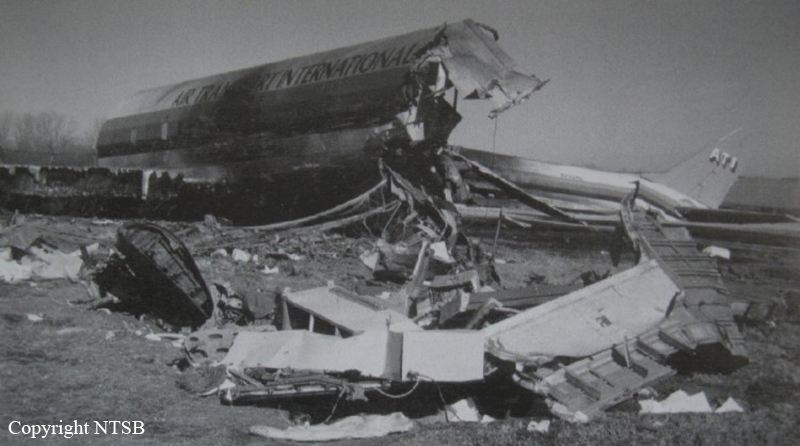
Crash of a Douglas DC-8-61F at Guantánamo Bay NAS
Date & Time:
Aug 18, 1993 at 1656 LT
Registration:
N814CK
Survivors:
Yes
Schedule:
Norfolk – Guantánamo Bay
MSN:
46127
YOM:
1969
Flight number:
CB808
Crew on board:
3
Crew fatalities:
Pax on board:
0
Pax fatalities:
Other fatalities:
Total fatalities:
0
Captain / Total hours on type:
1527.00
Copilot / Total hours on type:
492
Aircraft flight hours:
43947
Aircraft flight cycles:
18829
Circumstances:
Flight 808 took off from Norfolk at 14:13 for a cargo flight to Guantánamo Bay. The flight and arrival into the Guantánamo terminal area was uneventful. At 16:34, while the flight was descending from FL320, radio contact was established with the Guantánamo radar controller. The radar controller instructed flight 808 to maintain VFR 12 miles off the Cuban coast and report at East Point. The runway in use was runway 10. The flight crew then requested a runway 28 approach, but changed this back to a runway 10 approach a couple of minutes later. Clearance was given at 16:46 with wind reported at 200°/7 knots. The runway 10 threshold was located 0,75 mile East of Cuban airspace, designated by a strobe light, mounted on a Marine Corps guard tower, located at the corner of the Cuban border and the shoreline. On the day of the accident, the strobe light was not operational (both controller and flight crew were not aware of this). The aircraft was approached from the south and was making a right turn for runway 10 with an increasing angle of bank in order to align with the runway. At 200-300 feet agl the wings started to rock towards wings level and the nose pitched up. The right wing appeared to stall, the aircraft rolled to 90deg. angle of bank and the nose pitched down. The aircraft then struck level terrain 1400 feet west of the approach end of the runway and 200 feet north of the extended centreline.
Probable cause:
The impaired judgement, decision-making, and flying abilities of the captain and flight crew due to the effects of fatigue; the captain's failure to properly assess the conditions for landing and maintaining vigilant situational awareness of the airplane while manoeuvring onto final approach; his failure to prevent the loss of airspeed and avoid a stall while in the steep bank turn; and his failure to execute immediate action to recover from a stall. Additional factors contributing to the cause were the inadequacy of the flight and duty time regulations applied to 14 CFR, Part 121, Supplemental Air Carrier, international operations, and the circumstances that resulted in the extended flight/duty hours and fatigue of the flight crew members. Also contributing were the inadequate crew resource management training and the inadequate training and guidance by American International Airways, Inc., to the flight crew for operations at special airports such as Guantanamo Bay; and the Navy's failure to provide a system that would assure that local tower controller was aware of the inoperative strobe light so as to provide the flight crew with such information.
Final Report:
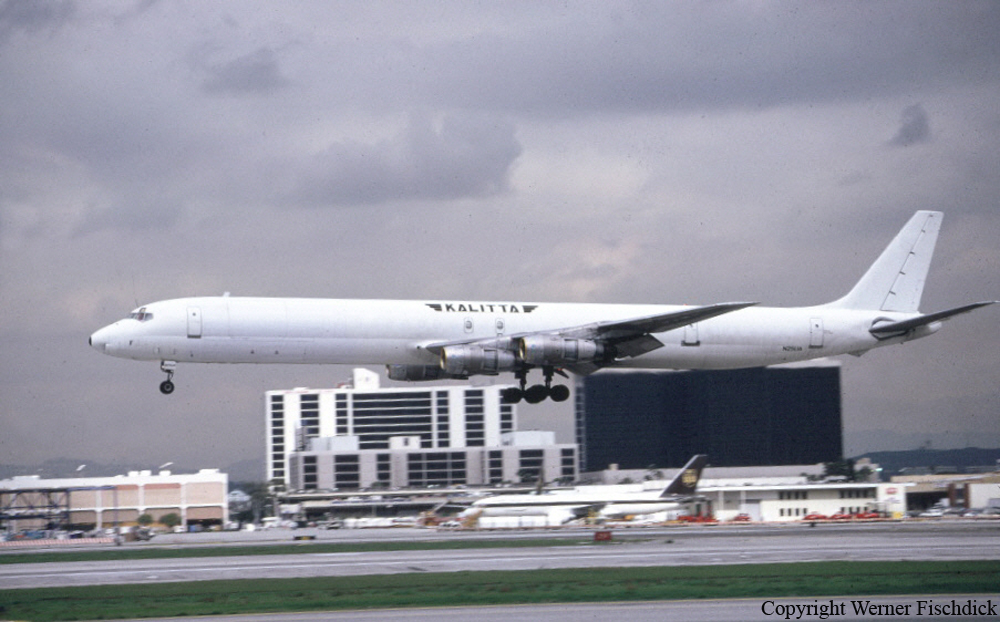


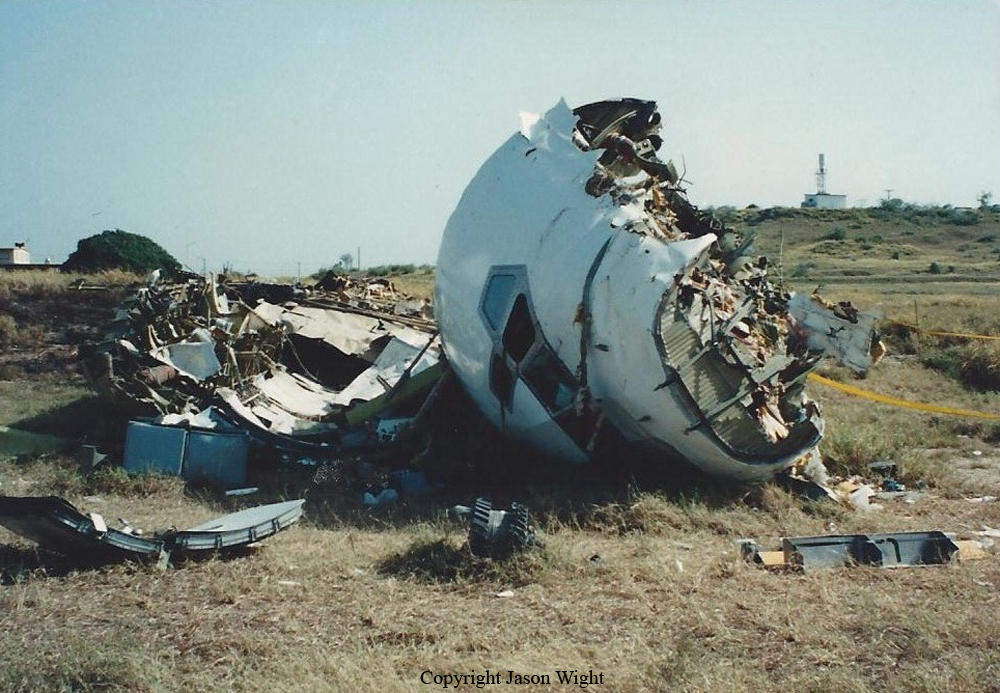
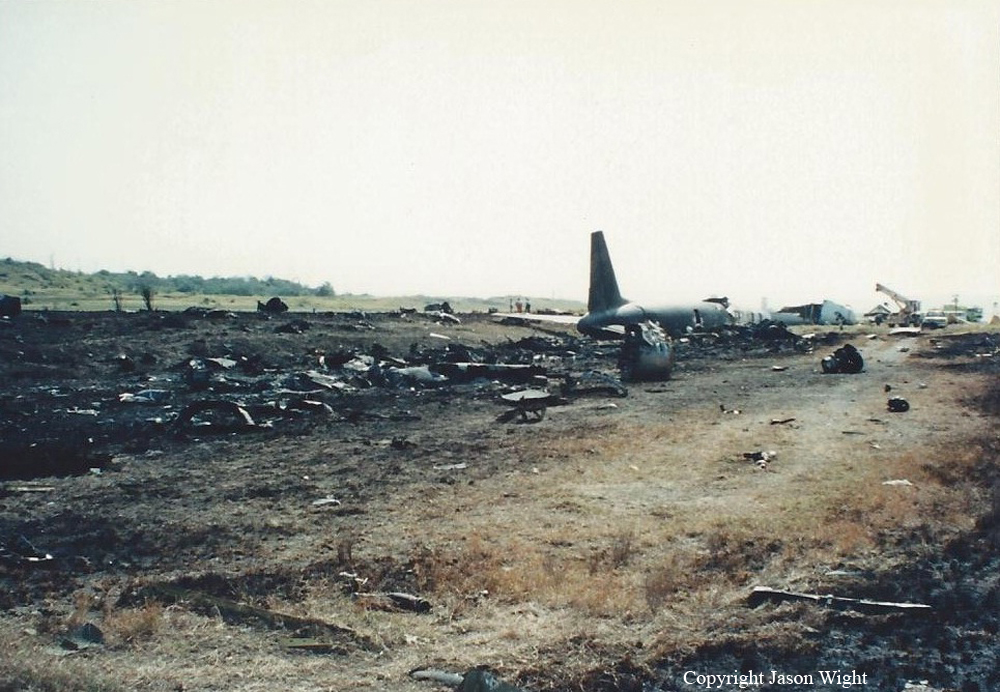
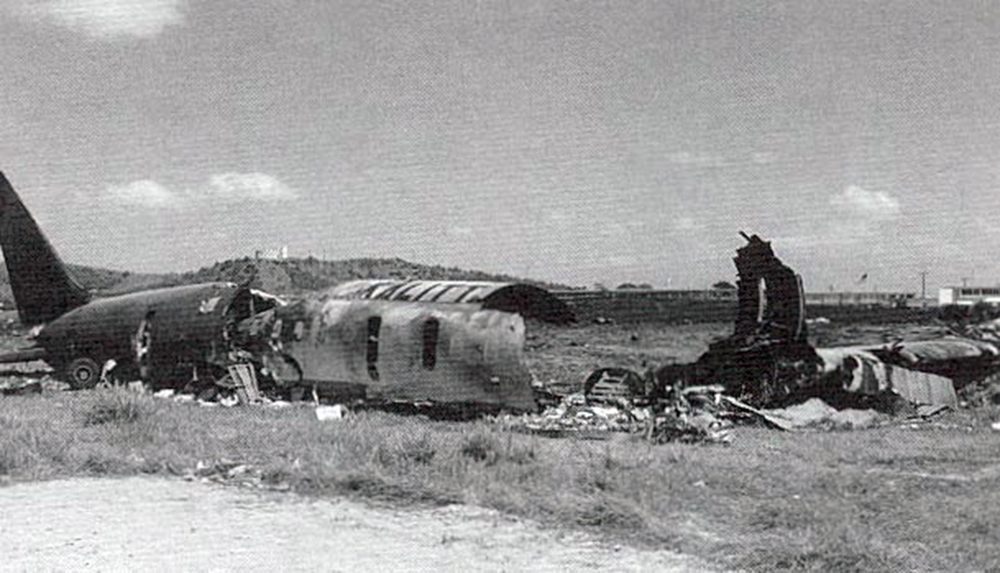
Crash of a Douglas DC-8-55 in Medellín
Date & Time:
Oct 15, 1992
Registration:
HK-3753X
Survivors:
Yes
Schedule:
Miami – Medellín
MSN:
45765
YOM:
1966
Crew on board:
3
Crew fatalities:
Pax on board:
0
Pax fatalities:
Other fatalities:
Total fatalities:
0
Circumstances:
After touchdown at Medellín-Enrique Olaya Herrera Airport, the crew lost directional control and the airplane deviated to the left. Suspecting an asymmetrical thrust, the captain decided to deactivate the reverse thrust systems when the aircraft veered off runway, collided with runway lights, lost its nose gear and came to rest. All three crew members escaped uninjured while the aircraft was damaged beyond repair.
Probable cause:
Loss of directional control upon landing for unknown reasons.
Crash of a Douglas DC-8-33AF in Iquitos
Date & Time:
Mar 28, 1992
Registration:
OB-1456
Survivors:
Yes
MSN:
45272
YOM:
1960
Crew on board:
3
Crew fatalities:
Pax on board:
3
Pax fatalities:
Other fatalities:
Total fatalities:
0
Circumstances:
After landing at Iquitos-Coronel Francisco Secada Vignetta runway 06, the crew started the braking procedure when, at a speed of about 100 knots, the nose gear collapsed. The aircraft slid for few dozen metres before coming to rest. All six occupants escaped uninjured and the aircraft was damaged beyond repair.
Probable cause:
Failure of the nose gear due to the fracture of the upper cap of the nose gear shock strut which in turn led to the failure of the control arms of the down lock safety mechanism.

Crash of a Douglas DC-8-63F in Toledo: 4 killed
Date & Time:
Feb 15, 1992 at 0326 LT
Registration:
N794AL
Survivors:
No
Schedule:
Seattle - Toledo
MSN:
45923
YOM:
1968
Flight number:
ATI805
Crew on board:
3
Crew fatalities:
Pax on board:
1
Pax fatalities:
Other fatalities:
Total fatalities:
4
Captain / Total hours on type:
2382.00
Copilot / Total hours on type:
1143
Aircraft flight hours:
70425
Aircraft flight cycles:
22980
Circumstances:
ATI Flight 805 departed from Seattle at 23:20 for a flight to Toledo. The 1st officer was flying the ILS approach to runway 07. For undetermined reasons, he failed to properly capture the ILS localizer and/or glide slope during the approach. At 03:13 the captain decided to carry out a go-around. The aircraft was vectored onto a base leg and given a heading of 100° to intercept the final approach course again. With a 35 knots crosswind (at 180°) on the approach the 1st officer had trouble capturing the localizer/glide slope. At 03:24, as the 1st officer was attempting to stabilize the approach, 3 GPWS glideslope warnings and sink rate warnings sounded. The captain took over control at 03:24:17 and performed another missed approach manoeuvre. He became spatially disoriented and inadvertently allowed an unusual attitude to develop with bank angles up to 80° and pitch angles up to 25°. When in a nose-low and left bank angle attitude, control of the airplane was transferred back to the 1st officer who began levelling the wings and raising the nose of the airplane. Impact with the ground occurred before the unusual attitude recovery was completed. All four occupants were killed.
Probable cause:
The failure of the flight crew to properly recognize or recover in a timely manner from the unusual aircraft attitude that resulted from the captain's apparent spatial disorientation, resulting from physiological factors and/or a failed attitude director.
Final Report:

Crash of a Douglas DC-8-54F in Kano
Date & Time:
Feb 15, 1992
Registration:
9G-MKB
Survivors:
Yes
Schedule:
Ostende - Kano
MSN:
45860
YOM:
1966
Crew on board:
5
Crew fatalities:
Pax on board:
0
Pax fatalities:
Other fatalities:
Total fatalities:
0
Circumstances:
On approach to Kano Airport, while in a flat attitude about 8 km from the runway threshold, the crew lowered the flaps when the aircraft lost height and struck trees. It descended into the ground, lost its undercarriage and slid for 150 metres before coming to rest, bursting into flames against trees. All five crew members escaped uninjured while the aircraft was damaged beyond repair.

Crash of a Douglas DC-8-61 in Jeddah: 261 killed
Date & Time:
Jul 11, 1991 at 0838 LT
Registration:
C-GMXQ
Survivors:
No
Schedule:
Jeddah - Sokoto
MSN:
45982
YOM:
1968
Flight number:
WT2120
Crew on board:
14
Crew fatalities:
Pax on board:
247
Pax fatalities:
Other fatalities:
Total fatalities:
261
Aircraft flight hours:
49318
Aircraft flight cycles:
30173
Circumstances:
A McDonnell Douglas DC-8-61 passenger plane, registered C-GMXQ was destroyed in an accident near Jeddah-King Abdulaziz International Airport (JED), Saudi Arabia. All 261 on board were killed. The DC-8 jetliner was owned by Canadian airline Nationair which operated the plane on behalf of Nigeria Airways to fly hajj pilgrims between Nigeria and Saudi Arabia. Nigeria Airways flight 2120 took off from Jeddah's runway 34L at 08:28, bound for Sokoto (SKO), Nigeria. About 15 seconds after brake release an oscillating sound was heard in the cockpit. Within two seconds, the flight engineer said: "What's that?" The first officer replied: "We gotta flat tire, you figure?" Two seconds later, an oscillating sound was again heard. The captain asked the first officer: "You're not leaning on the brakes, eh?" The first officer responded: "No, I 'm not, I got my feet on the bottom of the rudder." By this time, the aircraft had accelerated to about 80 knots. Marks on the runway showed that the No.1 wheel started to break up at about this time. In addition, the left and right flanges of No.2 wheel began to trace on the runway; rubber deposit from No.2 tire continued which appeared to be from a deflated tire between the flanges. At 28 seconds after brake release, a speed of 90 knots was called by the captain and acknowledged by the first officer. The captain called V1 about 45 seconds after brake release. Two seconds later, the first officer noted "sort of a shimmy like if you're riding on one of those ah thingamajigs." The captain called "rotate" 51 seconds after brake release and the airplane lifted off the runway. Witnesses noticed flames in the area of the left main landing gear. The flames disappeared when the undercarriage was retracted. During the next three minutes several indications of system anomalies occurred, which included a pressurization system failure, a gear unsafe light and a loss of hydraulics. The captain requested a level-off at 2000 feet because of the pressurization problem. In his radio call the captain used the callsign "Nationair 2120" instead of "Nigerian 2120" and the controller mistook the transmission to be from a Saudi flight returning to Jeddah and cleared The Jeddah bound aircraft to 3000 feet. The captain of the accident aircraft, however, acknowledged the ATC transmission without a call sign, saying "understand you want us up to 3000 feet." This misunderstanding continued for the next three minutes with ATC assuming that all calls were from the Saudi flight, not from the accident aircraft. About four minutes after brake release the captain called ATC and reported that the aircraft was leveling at 3000 feet. The first officer then interrupted with " ... declaring an emergency. We 're declaring an emergency at this time. We believe we have ah, blown tires." As the aircraft continued on the downwind heading, a flight attendant came into the cockpit and reported "smoke in the back ... real bad." A few moments later, the first officer said "I've got no ailerons." The captain responded: "OK, hang on, I've got it." It was the last record on the CVR, which failed (along with the flight data recorder [FDR]) at 08:33:33. The ATC controller gave a heading to intercept the final approach and thereafter continued to give heading information. Meanwhile, during the downwind and base legs, the fire had consumed the cabin floor above the wheel wells , permitting cabin furnishing to sag into the wheel wells. When the gear was probably extended at 11 miles on the final approach, the first body fell out because fire had burned through the seat harness. Subsequently, with the gear down and a forceful air supply through the open gear doors, rapid destruction of more floor structure permitted the loss of more bodies and seat assemblies. Despite the considerable destruction to the airframe, the aircraft appeared to be controllable. Eight minutes after brake release and 10 miles from the runway, the captain declared an emergency for the third time, saying, "Nigeria 2120 declaring an emergency, we are on fire, we are on fire, we are returning to base immediately." The aircraft came in nose down and crashed 9,433 feet (2,875 meters) short of the runway at 08:38.
Probable cause:
The following findings were reported:
1. The organisational structure for the deployment team was ill-defined and fragmented.
2. Deployment maintenance personnel were not qualified or authorised to perform the function of releasing the aircraft as being fit to fly.
3. The release of the aircraft as being fit to fly was delegated to non-practising Aircraft Maintenance Engineers whose primary function was to operate the aircraft as flight crew members.
4. The aircraft was signed-off as fit for flight, in an unairworthy condition, by the operating flight engineer who had no involvement in the aircraft servicing.
5. The #2 and #4 tyre pressures were below the minimum for flight dispatch. Other tyres may also have been below minimum pressures.
6. Maintenance personnel were aware of the low tyre pressures but failed to rectify the faults.
7. The mechanic altered the only record of the actual low pressures, measured by the avionics specialist on 7 July, four days before the accident.
8. There was no evidence that the tyre pressures had been checked, using a tyre pressure gauge, after 7 July.
9. The lead mechanic was aware of the low tyre pressures.
10. The persons who were aware of the low pressures had insufficient knowledge of the hazards of operating at low tyre pressures.
11. The project manager was aware of a low tyre pressure but was not qualified to assess its importance.
12. The project manager was responsible for the aircraft schedule and directed that the aircraft depart without servicing the tyre.
13. The lead mechanic who was aware of the requirement for, and had requested nitrogen for tyre servicing, did not countermand the decision of the project manager.
14. There was no evidence to indicate that this flight crew were ever informed of the low tyre pressures.
15. The aircraft departed the ramp in an unairworthy condition.
16. During the taxi from the ramp to the runway, the transfer of the load from the under-inflated #2 tyre to #1 tyre on the same axle, resulted in over deflection, over-heating and structural weakening of the #1 tyre.
17. The #1 tyre failed very early on the take-off roll due to degeneration of the structure, caused by over-deflection.
18. The #2 tyre failed almost immediately after #1 due to over-deflection and rapid overheating when the load was transferred from the #1 tyre.
19. The #2 wheel stopped rotating for reasons not established. Friction between the wheel/brake assembly and the runway generated sufficient heat to raise the temperature of tyre remnants above that required for a tyre fire to be self-sustaining. Rubber remnants ignited during the take-off roll.
20. Numbers 1 and 2 wheels were severely damaged and at least one piece of #1 wheel rim struck the airframe, becoming embedded in the left flap.
21. The crew were aware of unusual symptoms early and throughout the takeoff roll; the captain continued the take-off.
22. The aircraft was not equipped with warning systems which would have provided the flight crew with adequate information on which to make a decision to reject the take-off after tyre(s) failure.
23. The captain did not receive sufficient cues to convince him that a rejected take-off was warranted.
24. The crew retracted the gear, consistent with company procedures, and burning rubber was brought into close proximity with hydraulic and electrical system components.
25. The evidence indicates that the wheel well fire involved tyres, hydraulic fluid, magnesium alloy and fuel. The fuel was probably introduced as a result of "burn through" of the centre fuel tank.
26. Fire within the wheel wells spread and intensified until the cabin floor was breached and control systems were disabled.
27. The fuel increased the intensity of the fire until, shortly before impact, airframe structural integrity was lost.
28. Tyre characteristics and performance are not adequately addressed during training and licensing of both flight crews and technical personnel.
29. The aircraft operator's tyre inflation pressures did not accurately reflect what was contained in the aircraft manufacturer's maintenance manual.
30. The operator's maintenance and operating documentation for the DC-8 does not contain adequate information for the proper maintenance and operation of aircraft tyres.
1. The organisational structure for the deployment team was ill-defined and fragmented.
2. Deployment maintenance personnel were not qualified or authorised to perform the function of releasing the aircraft as being fit to fly.
3. The release of the aircraft as being fit to fly was delegated to non-practising Aircraft Maintenance Engineers whose primary function was to operate the aircraft as flight crew members.
4. The aircraft was signed-off as fit for flight, in an unairworthy condition, by the operating flight engineer who had no involvement in the aircraft servicing.
5. The #2 and #4 tyre pressures were below the minimum for flight dispatch. Other tyres may also have been below minimum pressures.
6. Maintenance personnel were aware of the low tyre pressures but failed to rectify the faults.
7. The mechanic altered the only record of the actual low pressures, measured by the avionics specialist on 7 July, four days before the accident.
8. There was no evidence that the tyre pressures had been checked, using a tyre pressure gauge, after 7 July.
9. The lead mechanic was aware of the low tyre pressures.
10. The persons who were aware of the low pressures had insufficient knowledge of the hazards of operating at low tyre pressures.
11. The project manager was aware of a low tyre pressure but was not qualified to assess its importance.
12. The project manager was responsible for the aircraft schedule and directed that the aircraft depart without servicing the tyre.
13. The lead mechanic who was aware of the requirement for, and had requested nitrogen for tyre servicing, did not countermand the decision of the project manager.
14. There was no evidence to indicate that this flight crew were ever informed of the low tyre pressures.
15. The aircraft departed the ramp in an unairworthy condition.
16. During the taxi from the ramp to the runway, the transfer of the load from the under-inflated #2 tyre to #1 tyre on the same axle, resulted in over deflection, over-heating and structural weakening of the #1 tyre.
17. The #1 tyre failed very early on the take-off roll due to degeneration of the structure, caused by over-deflection.
18. The #2 tyre failed almost immediately after #1 due to over-deflection and rapid overheating when the load was transferred from the #1 tyre.
19. The #2 wheel stopped rotating for reasons not established. Friction between the wheel/brake assembly and the runway generated sufficient heat to raise the temperature of tyre remnants above that required for a tyre fire to be self-sustaining. Rubber remnants ignited during the take-off roll.
20. Numbers 1 and 2 wheels were severely damaged and at least one piece of #1 wheel rim struck the airframe, becoming embedded in the left flap.
21. The crew were aware of unusual symptoms early and throughout the takeoff roll; the captain continued the take-off.
22. The aircraft was not equipped with warning systems which would have provided the flight crew with adequate information on which to make a decision to reject the take-off after tyre(s) failure.
23. The captain did not receive sufficient cues to convince him that a rejected take-off was warranted.
24. The crew retracted the gear, consistent with company procedures, and burning rubber was brought into close proximity with hydraulic and electrical system components.
25. The evidence indicates that the wheel well fire involved tyres, hydraulic fluid, magnesium alloy and fuel. The fuel was probably introduced as a result of "burn through" of the centre fuel tank.
26. Fire within the wheel wells spread and intensified until the cabin floor was breached and control systems were disabled.
27. The fuel increased the intensity of the fire until, shortly before impact, airframe structural integrity was lost.
28. Tyre characteristics and performance are not adequately addressed during training and licensing of both flight crews and technical personnel.
29. The aircraft operator's tyre inflation pressures did not accurately reflect what was contained in the aircraft manufacturer's maintenance manual.
30. The operator's maintenance and operating documentation for the DC-8 does not contain adequate information for the proper maintenance and operation of aircraft tyres.


Crash of a Douglas DC-8-62F in New York
Date & Time:
Mar 12, 1991 at 0906 LT
Registration:
N730PL
Survivors:
Yes
Schedule:
New York - Brussels
MSN:
46161
YOM:
1971
Flight number:
8C102
Crew on board:
3
Crew fatalities:
Pax on board:
2
Pax fatalities:
Other fatalities:
Total fatalities:
0
Captain / Total hours on type:
3000.00
Aircraft flight hours:
50145
Circumstances:
Before flight, the flight engineer (f/e) had calculated 'v' speeds and horizontal stabilizer trim setting for takeoff, but neither the captain nor the 1st officer (f/o) had verified them. During rotation for takeoff, the captain noted that the forced needed to pull the yoke aft was greater than normal and that the aircraft would not fly (at that speed). Subsequently, he aborted the attempted takeoff. Realizing the aircraft would not stop on the remaining runway, he elected to steer it to the right to avoid hitting traffic on a highway near the departure end. The aircraft struck ILS equipment; the landing gear collapsed and all 4 engines tore away. Subsequently, the aircraft was destroyed by fire. Investigations revealed the f/e had improperly computed the takeoff data. He had calculated the 'v' speeds and horizontal stabilizer trim setting for 242,000 lbs; however, the actual takeoff wt was 342,000 lbs. Rotation speed (Vr) for this weight was 28 knots above the speed that was used. Investigations revealed shortcomings in the operator's flightcrew training program and questionable scheduling of qualified (but marginally experienced) crew members for the accident flight.
Probable cause:
Improper preflight planning/preparation, in that the flight engineer miscalculated (misjudged) the aircraft's gross weight by 100,000 lbs and provided the captain with improper takeoff speeds; and improper supervision by the captain. Factors related to the accident were: improper trim setting provided to the captain by the flight engineer, inadequate monitoring of the performance data by the first officer, and the company management's inadequate surveillance of the operation.
Final Report:
